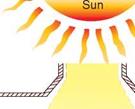Most important of all light sources for interior plantscapes is natural sunlight when it can be planned for and depended on. Each footcandle of illumination that nature provides is one less that has to be provided and paid for with artificial lighting. In our energy-conscious society, such savings are worth planning for. However, knowledge of how to maximize the benefits of natural light is vital; otherwise more heat energy is lost through inefficient windows than is gained in light energy.
Natural light is most helpful when it offers high levels of illumination throughout most of the year. Traditionally sunny areas like the Southwest can make better use of natural light than areas like the Northeast, where clouds block the sun and snow blankets the skylights through much of the winter season.
Sunlight entering from overhead is of greater use in the illumination of interior plantings than light entering from the side, although both are helpful. In neither situation will the natural light be as intense as outside light. It will be significantly reduced by the glass glazing through which it passes, and the distance it travels between the point of entry and the leaf surface. Little usable light passes more than 15 feet beyond glass, so skylights in high lobby areas or shopping malls are of no benefit to plantings beneath them. Nevertheless, they can be of great benefit in singlestory buildings with lower ceilings. In a similar fashion, a large interior plantscape may derive little benefit from side lighting, since usable light enters at a 45° angle and plants must be placed within the narrow beam
![]()

figure 8-2. Interior plantings receive the best quality of natural light within a 45° arc of the side windows. (Delmar/Cengage Learning)
![]()

![]()
![]() Sun
Sun
w
 |
і
/ i
/
narrow cone of usable light
for plant growth
figure 8-3. Cross-sectional views of skylights, and the influence of their design on the amount of usable light available to plants (Delmar/Cengage Learning) if they are to benefit (Figure 8-2). They cannot be too close to the glass or the foliage may burn, however. In a smaller room, as in a residence, natural side light can be of great value.
When skylights are used, they must be designed to permit the most light to enter while insulating against as much winter heat loss as possible. Within the limits allowed by heating and structural engineering, the ceiling well through which the light passes should be as wide and shallow as possible, with the sides painted a reflective white and beveled outward at 45° angles (Figure 8-3). As skylights become narrower and the ceiling well deeper, there is less area through which the sunlight can enter and a narrower focus of illumination on the surfaces below. The difference between wide, shallow skylights and narrow, deep ones is similar to the difference in illumination between a floodlight and a spotlight. With natural light and interior plantings, the wide floodlight effect is most desirable.



